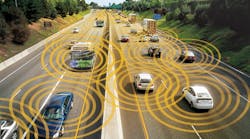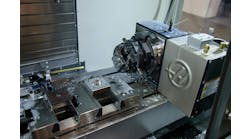A once-popular idea to equip cars with technology to communicate with one another and avoid collisions is encountering unexpected potholes in Washington.
An array of forces, from free-market groups opposed to government mandates to cable providers angling for greater access to high-speed wireless airwaves, have mounted opposition to a proposal that all new cars have vehicle-to-vehicle communications systems.
"This technology faces a huge number of hurdles, not the least of which is whether it’s even needed," said Mike Ramsey, an analyst with the technology research firm Gartner Inc. "There are a number of reasons why it may never get off the ground."
The Obama administration proposed the rule in December, saying it could eliminate 80% of vehicle crashes involving unimpaired drivers. If the rule is finalized, all new light-duty vehicles would be required within four years to be equipped with vehicle-to-vehicle communication systems. The technology will work hand-in-hand with new automated safety devices, such as automatic braking, in another step toward making driverless vehicles a reality, the Department of Transportation said at the time.
More than 400 people and organizations filed formal opinions with the National Highway Traffic Safety Administration by last week’s deadline, reflecting a wide range of viewpoints.
The proposal enjoys broad support from safety advocates, with the National Safety Council commenting that the technology adds a layer of awareness and redundancy to on-board vehicle sensors "that will be critical as higher levels of automation are deployed."
But automakers are split on the virtues of the plan, with some voicing strong support and others pointing out flaws in the government’s approach.
The Association of Global Automakers, a trade group that represents foreign-owned automakers including Toyota Motor Corp., Honda Motor Co. and Hyundai Motor Co., says that more than $1 billion in private and public funds have been spent developing the systems. The group says the mandate is "the best way to ensure nationwide deployment" as soon as possible, according to its filing with NHTSA.
Major automotive industry companies, including General Motors Co., Denso Corp., Delphi Automotive Plc and Toyota, have spent more than a decade developing vehicle-to-vehicle, or"V2V," communications systems.
"The safety benefit of V2V is undeniable. It will save lives, and everybody knows that," said Harry Lightsey, executive director of federal affairs for connected cars at General Motors. "A delay in rolling out V2V will cost lives, and that’s a tragedy."
One of the mandate’s loudest cheerleaders, General Motors earlier this year launched the first V2V-equipped vehicle, the 2017 Cadillac CTS. NHTSA’s proposed mandate is the best way to quickly advance the technology and to put a dent in the number of car crashes, Lightsey said.
The Alliance of Automobile Manufacturers, which represents a dozen automakers, including GM, Ford Motor Co. and Volkswagen AG, said NHTSA’s proposal needed additional clarity on several issues, including how security would be addressed, and asked for more time to implement the mandate than the proposal provides.
In its comment, Tesla Inc. said policy guidance and industry cooperation would be a better approach for encouraging V2V, calling NHTSA’s V2V strategy "too antiquated and vague" to protect the privacy of V2V messages.
Those messages are sent between cars 10 times per second using "dedicated short range communications" on airwaves reserved by the Federal Communications Commission in 1999.
Alternative Systems
BMW AG says the proposal would require automakers to use those airwaves to comply with the rule, even as alternative systems using cellular networks emerge. In its comment, the automaker urged NHTSA to take a technology-neutral approach, saying "many of the shortcomings of DSRC can be efficiently and cost effectively addressed" using cellular-based systems.
One company offering such as system is Israel-based startup Nexar Ltd. It began operating a smartphone app-based V2V network in New York City that now includes about 2,500 vehicles, Chief Executive Officer Eran Shir said. Data collected from the phone’s camera, GPS and internal gyroscope are analyzed in Nexar’s cloud system to warn drivers of impending collisions.
Shir says that NHTSA’s mandate would put cellular-based V2V technology like Nexar’s at a disadvantage because companies would prioritize investments to comply with the rule.
"I would totally understand if NHTSA said, ‘We’re interested in safety and we want these safety features,’" Shir said. "There are millions of lives at stake. What I think is less reasonable is if NHTSA comes and says we want to regulate the technology. That doesn’t make sense."
Old Technology
The failure to consider alternative technologies is a significant shortcoming of the proposal, says Marc Scribner, a senior fellow at the Competitive Enterprise Institute, who co-authored a letter with four other free-market advocacy groups asking regulators to suspend the proceeding.
"You’re betting on something that at its core is 10-year-old technology that isn’t going to have much of a difference on safety for 20 years," Scribner said. "By the time time it’s effective it will be out of date by 30 years."
The Internet and Television Association, the primary cable industry trade group, criticized the proposal for overstepping NHTSA’s authority by seeking to indirectly influence wireless spectrum policy overseen by the Federal Communications Commission. That agency is studying how vehicles and other Wi-Fi-enabled devices could share airwaves amid a lobbying push by cable and tech companies hungry for additional wireless bandwidth.
"NHTSA proposes to race to impose new regulations without developing a full record on alternatives, all in the hopes of narrowing the regulatory options available to the FCC," the cable group said.
Whether the proposal advances is now up to the Trump administration, which has erected hurdles to new regulations, including issuing an executive order requiring the cost of new rules be offset by savings from repealing others. The administration also hasn’t nominated a leader for NHTSA, the Transportation Department agency responsible for the rule.
Transportation Department spokeswoman Allison Moore said the proposed rule is still under "careful review," adding that "all views will be considered in the decision-making process."
By Ryan Beene




